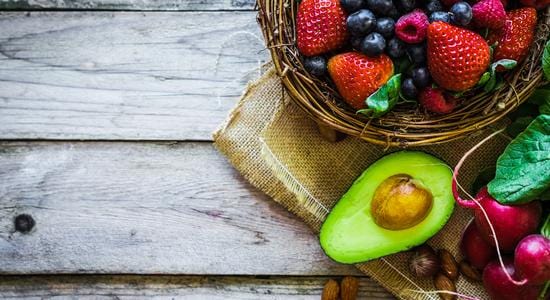Bowel habits differ from one person to another and having regular bowel movements can be a sign of healthy digestion.
Primary causes of irregular bowel movements in adults include dietary choices such as insufficient amounts of dietary fiber or water intake. It can be a short-term problem that may be sorted with a change in your diet. Changes could include more fiber in your diet and an increase in water intake. Fiber and water can help keep the digestive tract flowing, by keeping your bowel movements soft and regular .
Simple changes to your diet and lifestyle can help to improve your overall digestive health. Below, we have put together a list of top 5 foods to eat to help improve regularity.
1. Fruit
Kiwis are a highly effective dietary option to promote laxation (loosening of the stool)[1]. They contain antioxidants and are a good source of fiber. The fruit also contains an enzyme that can help break down protein2.
Bananas contain several essential nutrients and may have benefits for your digestion4. A medium sized banana contains around 3 grams of fiber[3].
Apples are a nutritious source of vitamins and fiber. The fiber they contain includes pectin, which may aid in digestion[4].
2. Spices & Herbs
Cumin has been traditionally used to treat constipation and promote digestion. The spice may aid in increasing the activity of digestive proteins[5].
Coriander makes is a great digestive aid as it can help with an upset stomach and intestinal gas.[6].
Turmeric is considered to have healing properties and early research suggested that turmeric may help improve digestion[7].
3. Legumes
Cooked legumes are nutritious, containing a healthy source of fiber and protein. It’s these fibers that pass undigested through the stomach and small intestine until they reach the colon, where they feed the friendly bacteria residing there[8].
Beans and lentils provide twice as much fiber as most vegetables. Green peas are the most frequently consumed type of pea. They are known as legumes as they come from a plant that produces pods with seeds inside. Peas contain lots of vitamins and minerals and fiber[9].
4. Vegetables
Along with the health benefits of vitamins and minerals found in vegetables, they are also a recommended source of dietary fiber[10].
Broccoli contains more protein than most other vegetables. It’s also high in many nutrients including fiber, vitamin C, iron and potassium17, with a reputation for benefiting digestion[11].
Celery is a great source of antioxidants and may also offer special benefits to the stomach. The high percentage of water content plus the soluble and insoluble fiber support a healthy digestive tract to keep you regular19.
5. Grains
Whole grains help deliver important nutrients and the bran within the grain provides most of the fiber, which is important for regularity[12].
Whole-grain bread has added antioxidants and important nutrients, including insoluble fiber. This type of bread has three times the fiber of white bread[13], so choose the healthier alternative.
Oats can have many health benefits as they contain more protein and fat than most grains and are a good source of carbohydrates23.
All these suggested foods can help digestion. However, it’s important to remember that although fiber works for some people, it is not a solution for everyone. While most people fall short on their recommended fiber intake, it is also possible to have too much fiber and worsen your digestive issues.
Sometimes you can’t always get what you need from your diet. Consistency and compliance in probiotic consumption is the key to help maintain proper balance for a regular digestive system.
Make some healthy diet and lifestyle changes today and see how it can improve your overall digestive health.
References:
[1] “Dietary fiber: Essential for a healthy diet” Mayo Clinic, 22 Sept 2015. www.mayoclinic.org/healthylifestyle/nutrition-and-healthy-eating/in-depth/fiber/art-20043983
[2] Drummond, Gearry. “Kiwifruit modulation of gastrointestinal motility” National Center for Biotechnology Information, 2013. www.ncbi.nlm.nih.gov/pubmed/23394990 4 Bjarnadottir, Adda. “11 Evidence-Based Health Benefits of Bananas” 3 Jun 2017.
www.healthline.com/nutrition/11-proven-benefits-of-bananas
[3] Buttris, Judith. “Dietary Fiber and Health” Wiley Online Library, 13 Aug 2008. onlinelibrary.wiley.com/doi/abs/10.1111/j.1467-3010.2008.00705.x
[4] Jennings, Kerri-Ann. “10 Impressive Health Benefits of Apples” Healthline, 3 Aug 2016. www.healthline.com/nutrition/10-health-benefits-of-apples
[5] Thorpe, Matthew. “9 Powerful Health Benefits of Cumin” Healthline, 23 Mar, 2017.
www.healthline.com/nutrition/9-benefits-of-cumin
[6] “Coriander” Web MD, Undated. www.webmd.com/vitamins-supplements/ingredientmono-117coriander.aspx?activeingredientid=117&activeingredientname=coriander
[7] Ratini, Melinda. “Health Benefits of Turmeric” Web MD, 20 Dec 2017. https://www.webmd.com/diet/ss/slideshow-turmeric
[8] Leech, Joe. “Legumes: Good or Bad?” Healthline, 4 Jun 2016. www.healthline.com/nutrition/legumes-good-or-bad
[9] Elliott, Brianna. “Why Green Peas are Healthy and Nutritious” Healthline. 24 Feb 2017. https://www.healthline.com/nutrition/green-peas-are-healthy
[10] Slavin, Joanne, “Health Benefits of Fruits and Vegetables” National Center for Biotechnology Information, 6 Jun 2012. www.ncbi.nlm.nih.gov/pmc/articles/PMC3649719/ 17 Bjarndottir, Adda. “Broccoli 101: Nutrition Facts and Health Benefits” Healthline, 26 Feb 2015.
www.healthline.com/nutrition/foods/broccoli
[11] Szalay, Jessie. “Broccoli: Health Benefits, Risks & Nutrition Facts” Live Science, 15 Jun 2017. www.livescience.com/45408-broccoli-nutrition.html 19 Timmons, Jessica. “5 Healthy Benefits of Adding Celery to Your Diet” 24 Feb. 2016.
www.healthline.com/health/food-nutrition/health-benefits-of-celery
[12] Jennings, Kerri-Ann. “9 Legitimate Health Benefits of Eating Whole Grains” Healthline, 23 Dec 2016. www.healthline.com/nutrition/9-benefits-of-whole-grains
[13] “Dietary Fiber” University Health Services, Undated. uhs.berkeley.edu/sites/default/files/dietaryfiber.pdf 23 Palsdottir, Hrefna. “9 Health Benefits of Eating Oats and Oatmeal” 19 July 2016.
www.healthline.com/nutrition/9-benefits-oats-oatmeal
* THESE STATEMENTS HAVE NOT BEEN EVALUATED BY THE FOOD AND DRUG ADMINISTRATION. THESE PRODUCTS ARE NOT INTENDED TO DIAGNOSE, TREAT, CURE OR PREVENT DISEASE.
